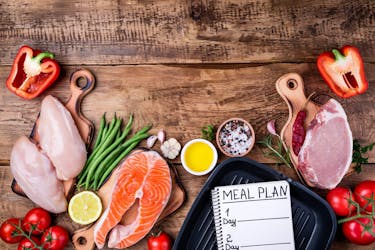
Smart Budgeting
How To Create a Cashflow-Positive Budget ... and Stick To It!
In This Article
Would you like to save an extra $1,222 a year and get a buff bod? Who wouldn’t, right? Well, the good news is if you’re eating lunch out at work every day, these things are easily within your reach . . . if you start packing. Keep reading to learn how to save money on lunch.
Consider the facts. The cost of eating out is $11 per meal on average, whereas preparing your own lunch costs around $6.30 per meal. Over the course of a year, you could save $1,222 if instead of eating out for lunch each day, you began packing your lunch.
Just think about what you could do with an extra $1,000+ each year…you could pay off credit card debt faster, start investing, pad your budget for emergencies, or even head off for a week-long vacation to a sun-drenched, tropical location. Good stuff, right?!
But that’s just for starters . . .
Bringing your lunch to work is also a super-easy way for you to start improving your physique. Unfortunately, most restaurant meals are packed with calories. According to one recent study, 92% of meals eaten out fall into that category. Even the so-called “healthier” options are far from perfect.
By packing a healthy lunch every day—rather than opting for fast food or a restaurant meal—you’ll cut down on hundreds of extra calories each week.
And because you won’t waste time in line buying lunch anymore, your lunch hour will seem that much longer. If you want to use the time you saved by brown-bagging in a really productive way, you can even take a brisk half-hour walk.
The benefits are clear—by preparing a lunch the night before work each day, you’ll save time and money, while cutting calories.
Having said all that, you’re probably wondering how you can make this a habit. No worries, we can help.
In this article, you’re going to learn how to save money on lunch with no-fuss meals, what you can do to meal plan for the week ahead, and get our top tips for making your new habit a no-brainer.
So to kick things off, let’s talk about meal planning.
How To Save Money on Lunch: Meal Planning Made Simple

If you want to be successful with brown bagging, you’ve got to plan. Unfortunately, just waking up each morning and scavenging around in your refrigerator won’t yield the best results.
However, with a little advanced preparation, you can easily develop a system that’ll work well, week after week.
Get the Essentials
It’s easier to stick to a new habit when you set yourself up for success. When it comes to lunch preparation, that means making sure you have the essentials on hand.
So, we recommend picking up Tupperware containers, plastic wrap, and brown bags. If you want to go the extra mile, a reusable lunch bag and an ice pack are great picks and environmentally-friendly.
Create a Grocery List
Great lunches don’t just happen--they involve a little advance planning. So, start thinking about easy items you can use to make a number of different lunches. For example, we recommend the following food items for maximum convenience:
- Pasta or Grains (Like Quinoa)
- Bread or Wraps
- Crackers, Pretzels, and/or Pita Chips
- Lunch Meats and Cheeses
- Eggs
- Rotisserie Chicken
- Fruits and Vegetables
- Dipping Sauces (Like Ranch Dressing or Hummus)
- Canned Soups
- Canned Tuna or Salmon
- Salad Ingredients
You can create tons of different lunches by coupling these everyday items with food items you already have in your cupboards.
For instance, you can shred your rotisserie chicken and use it in several different ways—make a chicken salad sandwich, turn canned soup into a heartier meal, add protein to a salad, fill a wrap, or toss it with pasta and marinara sauce.
You’ll find that eggs are also pretty versatile. You can use them to make egg salad, improve upon tuna salad, add a protein topper for your salad, or even pack as a snack to accompany your lunch.
If you keep your kitchen stocked with these basics, you’ll have plenty of opportunities to get creative and try new combinations. If you want to make things even easier, make larger dinners each night and pack your leftovers for the next day.
Shop Once a Week
Let’s be honest—a lot of new habits never become ingrained, because we don’t plan for them.
So, rather than sticking to our new diet, we grab something from the vending machine, because we didn’t bring a healthy snack. Instead of heading to the gym after work, we skip it, because we forgot our workout clothes (etc).
Don’t sabotage your newfound commitment to brown bagging by not preparing in advance. Instead, plan a weekly date to the grocery store and stick to it. Once you get into this habit, you’ll wonder how you managed to avoid doing it for so long.
Prepare
Pick a day each week to do as much preparation work as you can for the lunches you’ll be making.
While you may not want to make sandwiches in advance, there are plenty of other tasks you can do that’ll make it really easy for you to quickly assemble your lunch each night for the next day. For instance, you can:
- Cook up pasta and grains.
- Shred rotisserie chicken, so you can add it to any meal.
- Hard-boil eggs.
- Cut up vegetables and fruit.
- Create layered salads in mason jars for the week ahead.
- Make a stew or slow-cooked meal, then freeze it in small lunch-sized portions.
Helpful hint: Many of the meals you plan to bring to work can be prepared in advance and then frozen in individual serving sizes.
In the morning, just grab a container out of the freezer to take to work. By the time lunchtime rolls around, your food will have defrosted. This should make it nice and easy to heat up in the microwave.
How to Save Money on Lunch
Now that you’ve learned how to easily prepare your workday lunches, let’s talk about how you can save even more money by doing this.
Set a Goal
Goals help us stay on track. Wishing for improvement isn’t quite the same thing as planning for improvement, and that’s what goal-setting does.
So, as you start your new brown bagging initiative, create a goal in advance. How many times a week would you like to bring your lunch from home? Will you allow “cheat” days?
Once you know what you’re aiming for, you’ll find it easier to stay on track.
Shop Cheap
As we’re sure you know, grocery shopping at Whole Foods is nothing like grocery shopping at Trader Joe’s. If you’re really serious about saving money, we recommend:
- Shopping at stores known for value, like Trader Joe’s, Costco, Sam’s Club, Walmart, and grocery store outlets.
- Buying food in bulk.
- Stocking your pantry with herbs, spices, and other essentials you can easily find at the dollar store.
- Cutting up vegetables and fruit yourself, rather than buying pre-cut ones.
- Eliminating meat one or more days a week.
- Taking advantage of BOGO (Buy One, Get One) offers when possible.
Clip Coupons
Each week you probably get a flyer in the mail, listing the weekly specials at your grocery store. Take advantage of these! If you’re really gung-ho about savings, you can also clip coupons, either with a scissors or using your grocery store app.
These days most grocery stores have apps that make coupon clipping super-simple. Just login to the app, look for your favorite items, and use the app to add the associated coupons to your grocery store card.
In addition to offering coupons on specific products, many grocery stores offer $5 or $10 off coupons on your overall grocery store purchase. Don’t forget to scan the app for these types of coupons.
The coupons you select in the app are easily redeemable. The next time you check out at the store, simply scan your grocery store card and the savings will be applied directly to your order.
Making Your New Habit Easy

Let’s be honest. Whenever we get a new idea about how to save money, get a better body, quit smoking, etc, we always begin with a lot of enthusiasm.
However, that enthusiasm tends to wane over time until eventually, our new habit dwindles off and we give up on it altogether.
Yet, there are ways to overcome this common problem. Learn our top tips for turning your new brown-bagging habit into a lifelong one.
Make It a Group Effort
It’s so much easier to accomplish a goal when we have a team of people supporting us.
Rather than tackling your brown-bagging goal solo, see if you can enlist your coworkers to join you.
Not only will you enjoy the extra support, but you’ll also find that skipping lunches out is a lot easier when you’re not regularly hearing, “Hey, we’re having lunch at Chipotle. Wanna join us?”
Plan for the Occasional Indulgence
It’s important to be realistic with yourself. If you’ve been buying your lunches regularly, it can be a big change to suddenly go cold turkey on that. Rather than setting yourself up for slip-ups, plan for indulgences.
We recommend picking one day a week where you can grab lunch with your coworkers, so you have the occasional meal out to look forward to.
By permitting—and planning for—occasional indulgences, you’ll find it easier to stick to brown-bagging the other four days of the week.
Leave Your Office
Can we be frank? It’s depressing to eat a sandwich in front of your computer monitor while you respond to work-related emails between bites of your sandwich. Don’t do that!
Instead, we suggest leaving your desk during lunch, so your new habit doesn’t bum you out. You can head to your office cafeteria, visit a local park, or even eat in your car and jam out to tunes if you want.
If none of those options are realistic for you, at least try to go on a walk after eating lunch at your desk. The fresh air and change of scenery will give you a much better outlook when you return to the office.
Commit for a Month
Typically, it takes a few weeks before a new habit becomes a way of life. So, to make your new money-saving lunch routine stick, commit in advance to giving it a full 30 days. Then, at the end of the month, evaluate.
How much money did you save? How did your body respond to fewer calories? How easy did you find brown-bagging? What could you have done to make it even easier?
By answering those questions, you can see for yourself if the benefits are worth it.
If you find that they are—but that buying pre-cut vegetables would make it so much easier to stick to it—then start doing that.
You want to give yourself some flexibility here because a few minor adjustments along the way can make your long-term lunch-packing goal that much easier.
And speaking of long-term goals…
Put Aside the Money You’re Saving
Packing your lunch will definitely save you money. So, think about what you want to do with all the extra cash you’re going to have, once you’re no longer spending lots of money on lunch.
Do you want to pay a credit card bill off early? Go on that cruise you’ve been dreaming of? Make one extra mortgage payment a year, so you can start shaving years off your loan payments?
Yes, regularly bringing lunch from home is a good goal all on its own. But you’ll find it even easier to stick with it, once you start seeing all the extra money add up that you used to spend on eating out.
That’s why we recommend that you decide before you even start your new lunch-packing habit, how you’re going to spend the extra money.
Then, each week put that money aside into a special account or toward a bill, so you can either watch your savings grow or your debts decrease. That’ll give you extra incentive to follow through over the long haul.
Brown Bagging . . . You Got This
Bringing lunch from home is one of the easiest ways to add a cushion to your budget, and there’s no better time like the present to work toward your new money-saving lunch goal.
To make it super-simple, here’s our quick-start guide:
- Set Goals (# of Days Per Week You Plan to Brown Bag & Financial).
- Create a Grocery List (Don’t Forget Essentials Like Tupperware).
- Pick a Day for Shopping and Prepping.
That’s it! That's how to save money on lunch.
Remember the extra $1,222 and buff bod we talked about earlier?
Follow the simple tips in this guide, and you’ll be well on your way to them!






